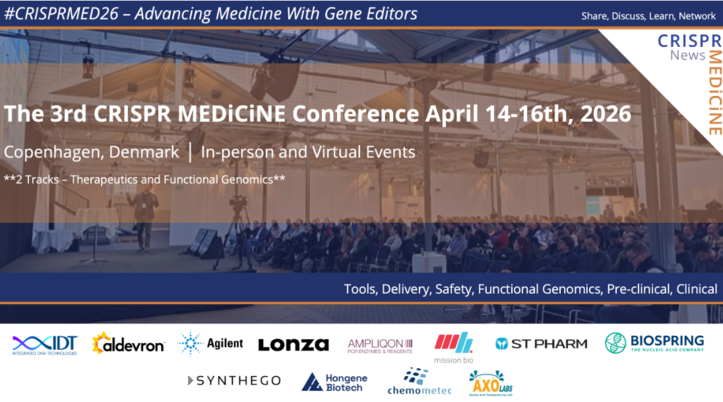CMN Weekly (14 August 2022) - Your Weekly CRISPR Medicine News
By: Karen O'Hanlon Cohrt - Aug. 14, 2022
Top picks
- Genome Editing Terminology Is Standardized in NIST-Led Effort. Read about what the National Institute of Standards and Technology (NIST) Genome Editing Consortium is doing to standardise the terminology surrounding gene editing so that scientists anywhere in the world can precisely describe the details of their genome-editing attempts in a common language.
Research
- In an article published in Nature Biotechnology earlier this week, scientists in China report a novel dual-fluorescence reporter system for detecting collateral effects and screening Cas13 variants in mammalian cells. The team analysed more than 200 engineered Cas13 variants and found that several of them, including Cas13d and Cas13X, exhibit efficient on-target activity but markedly reduced collateral activity. They also found that transcriptome-wide off-targets and Cas13-induced cell growth arrest are absent for these variants. The authors conclude that high-fidelity Cas13 variants with minimal collateral effects are now available for targeted degradation of RNAs in basic research and therapeutic applications.
- A team of researchers at multiple institutes in the U.S. has performed three inducible CRISPR inhibition and activation (CRISPRi and CRISPRa) screens to elucidate functional consequences of genetic perturbations in human induced pluripotent stem cell-derived microglia. Among the findings were genes that controlled microglia survival, activation and phagocytosis, including neurodegeneration-associated genes. An additional screen with single-cell RNA sequencing as the readout revealed that these microglia adopt a spectrum of states mirroring those observed in human brains, and identified regulators of these states. The findings were published this week in Nature Neuroscience.
- In an article published in Nature Communications this week, researchers in China, U.S. and Australia report the establishment of a CRISPR activation (CRISPRa) mouse for inducing gene expression in vivo and in vitro. Using dCas9a-SAMKI primary lymphocytes, they induced B-cell restricted genes in T cells and vice versa, demonstrating the power of this system. They also used this system to generate a cellular model of aggressive double hit lymphoma that, upon transplantation in mice, led to rapid onset of lymphomas expressing high BCL-2 and MYC. The findings, which can be found here, demonstrate the potential of the CRISPRa model for mimicking disease and provide insights into resistance mechanisms towards targeted therapies.
Industry
- Fate Therapeutics announces pre-clinical publication in Nature Biomedical Engineering highlighting derivation of CD8αβ T cells from TCR-CAR+ induced pluripotent stem cells. The study results demonstrate the successful generation, durable anti-tumour response, and functional persistence of the cells, and according to study leader Michel Sadelain MD, PhD (Memorial Sloan Kettering Cancer Center), the study is the first to show the generation of iPSC-derived CD8αβ CAR T cells lacking a TCR, where timed and calibrated expression of the CAR in place of the TCR successfully drove T-cell maturation and promoted the acquisition of a transcriptional and functional profile more closely resembling that of natural CD8αβ T cells. Read the press release here.
- Graphite Bio has dosed the first patient with its investigational gene-editing therapy GPH101 (now called nulabeglogene autogedtemcel, nula-cel)in the Phase 1/2 CEDAR trial for sickle cell disease. Nula-cel is an investigational gene-editing therapy designed to directly correct the genetic mutation that causes SCD and definitively cure the disease. Read more about nula-cel in a previous clinical trial update.
- ProQR Therapeutics announced in a press release earlier this week that it will focus exclusively on its Axiomer RNA-editing technology and partner its ophthalmology programmes. The announcement follows feedback from the European Medicines Agency, which recommends that an additional clinical trial be conducted for ProQR's RNA-editing candidate sepofarsen (for Leber congenital amaurosis) prior to submitting a Marketing Authorisation Application (MAA). In light of this feedback, and to continue advancement of its ophthalmic product candidate portfolio, the company will seek to identify a strategic partner to advance the ophthalmology portfolio.
- Several CRISPR companies have announced financial results for the second quarter of 2022: Allogene Therapeutics, Poseida Therapeutics, Beam Therapeutics, CRISPR Therapeutics, Precision Biosciences, Caribou Biosciences, Graphite Bio, Verve Therapeutics, Century Therapeutics.
Detection
- A team of researchers led by Imperial College London, MIT, and Max Delbrück Center for Molecular Medicine in Berlin has developed a new molecular biomarker test called CrisprZyme, with applications in personalised diagnostics for non-infectious diseases such as heart attacks and cancer. The test combines a CRISPR–Cas-based reaction with a nanozyme-linked immunosorbent assay, which allows for the quantitative and colorimetric readout of Cas13-mediated RNA detection through catalytic metallic nanoparticles at room temperature. The team demonstrated that CrisprZyme is easily adaptable to a lateral-flow-based readout and different Cas enzymes and enables the sensing of non-coding RNAs including microRNAs, long non-coding RNAs and circular RNAs. The findings were recently published in Nature Nanotechnology.
- In an article published in Nature Communications this week, scientists in China report a new ultrasensitive CRISPR-based antibody detection (UCAD) assay that translates the detection of anti-SARS-CoV-2 antibodies into CRISPR-based nucleic acid detection in a homogeneous solution and is 10,000 times more sensitive than the classic immunoassays. Using 197 serum samples collected from the general population, the team demonstrated that UCAD has 100% sensitivity and 98.5% specificity, and the method also allowed quantitative analysis of serum anti-SARS-CoV-2 levels in vaccinated kidney transplant recipients who are shown to produce “undetectable” anti-SARS-CoV-2 using standard immunoassay. The team will proceed to perform clinical validation against large cohorts of clinical samples.
Reviews
- CRISPR/dCas9 for hepatic fibrosis therapy: implications and challenges. This review presents the potential implications and describe the challenges of CRISPR-dCas9 system that might be encountered in hepatic fibrosis therapy.
- An overview: CRISPR/Cas-based gene editing for viral vaccine development. This review addresses recent advances in the CRISPR-Cas system for the development of vaccines and viral vectors for delivery. The authors also discuss strategies for the development of CRISPR-based vaccines, as well as the limitations and future prospects of the CRISPR-Cas system.
- New Advances in Using Virus-like Particles and Related Technologies for Eukaryotic Genome Editing Delivery. This review summarises recent developments surrounding the use of virus-like particles (VLPs) for safe delivery of gene-editing effectors. The review starts with background information on how VLPs can be used for safe and efficient CRISPR-Cas9 delivery, before summarising recently developed VLPs as genome-editing vehicles. The authors finish with a discussion on applications and future directions.
News from CRISPR Medicine News
- Multiplex CRISPR Merges With Click Chemistry! For this week's feature article, we interviewed Julianne Gibbs and Matthew Macauley, both of whom are associate professors at the Department of Chemistry, University of Alberta in Edmonton, Canada. Their latest study took advantage of click chemistry to improve the efficiency of guide RNA synthesis, so that guides can now be synthesised efficiently as three short fragments that readily snap together into one functional single guide RNA. The new modular assembly system also enables easy mix and match of modified or labelled nucleotides, and it facilitates multiplex CRISPR experiments. Read the interview here.
- In the latest CRISPR AgroBio News (CARBON) biweekly newsletter, you'll find links to a new CRISPR-based approach to rice eating and cooking quality that targets the crop's grain protein content. Read the latest CARBON Newsletter here. Sign up to receive the CARBON Newsletter directly into your inbox here.
To get more of the CRISPR Medicine News delivered to your inbox, sign up to the free weekly CMN Newsletter here.
Tags
CLINICAL TRIALS
IND Enabling
Phase I
Phase II
Phase III
Recurrent or Progressive High-grade Glioma, (NCT06737146)
Sponsors:
Suzhou Maximum Bio-tech Co., Ltd.
Sponsors:
Suzhou Maximum Bio-tech Co., Ltd.
IND Enabling
Phase I
Phase II
Phase III
Advanced Peritoneal Malignancies or Abdominal Metastatic Solid Tumors, (NCT06912152)
Sponsors:
Zhejiang University
Sponsors:
Zhejiang University
IND Enabling
Phase I
Phase II
Phase III







